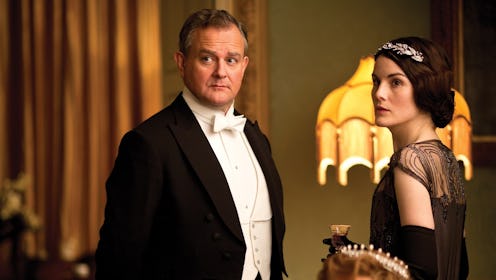
It's a fear Mr. Carson and the Dowager have been dreading for quite some time now, but it seems Downton Abbey Season 5 is finally catching up with the modern times. (Well, modern for the 1920s, at least.) That's right, lords and ladies — Sunday night's episode will see Downton and the Crawleys tackle technology by investing in a wireless, which is basically an English term used to describe a radio. Of course, nowadays, the concept of the word "wireless" means a far different thing than it did back then, so don't be confused in thinking Mrs. Hughes or Mary will be carrying around a laptop and using WiFi or a Hotspot. (Though who wouldn't enjoy seeing that?)
So how does it exactly work then? Well, I won't bore you with too many intricate details (we all know the basic premise of what a radio does). However, I will say that even though it was referred to as wireless, it ironically consisted of quite a few wires within its actual structure. Why call it a wireless then? As a matter of fact, it had more to do with how the information/message was being received. Prior to this, everyone communicated strictly via a telephone or telegraph, which arrived by wire. But here, the introduction to radio broadcasting made use of radio waves rather than wires, thereby making it, in fact, wireless.
And just for good measure, here's a further breakdown of the change-up according to the Radio Corporation of America (RCA):
What began as wireless telegraphy, sending dots and dashes through the air instead of over wires, grew to become voices and music transmitted and received over the air with the development of more sensitive transmission and receiving equipment.
Sure, it may not seem all that exciting to us given the tech-crazed modern age that we live in, but such a change was considered quite the technological advancement back then. I mean, the idea of being able to listen to music that was occurring thousands of miles away was unfathomable in those days. Normally, if you wanted to go hear a band play or listen to the King of England give a speech, you would actually have to go there and witness it all firsthand. And speaking as someone who never wants to experience Times Square during the ball drop on New Year's Eve, let me assure you that sometimes being there in person feels massively overrated.
But that's what made the wireless so unique and groundbreaking. Now our fellow residents of Downton could be privy to entertainment and politics without ever leaving the comfort of one of their many living rooms. Granted, the device itself was still quite the process to set up back then. It needed to be properly tuned and adjusted, usually by a professional. (How anyone ever survived without the help of Google I'll never know.) Furthermore, it was mostly made out of wood accompanied by numerous round dials on the front and a separate speaker off to the side, like so:
Suffice to say, it was a rather bulky piece of equipment, which as we all know will only continue to get slimmer and slimmer with time. (Just look at our iPhones and iMacs for inspiration.) So you Crawleys might as well make peace with the concept right now because this isn't just some fad whose popularity will eventually fade away in a few months. Technology is the wave of the future, my friends, and will help get you ready for what comes next… a television!
Images: PBS; ohsoyourealibrarian/Tumblr; jagfeed/Tumblr; YouTube [screen grab]; Wifflegif